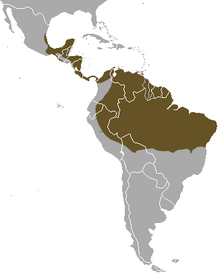Galictis vittata
| Greater grison | |
|---|---|
 |
|
| Scientific classification | |
| Kingdom: | Animalia |
| Phylum: | Chordata |
| Class: | Mammalia |
| Order: | Carnivora |
| Family: | Mustelidae |
| Genus: | Galictis |
| Species: | G. vittata |
| Binomial name | |
|
Galictis vittata (Schreber, 1776) |
|
 |
|
| Greater grison range | |
| Synonyms | |
|
Galictis allamandi Bell 1837 |
|
Galictis allamandi Bell 1837
The greater grison (Galictis vittata), is a species of mustelid native to South and Central America.
The greater grison is a slender animal with short legs, a long neck, and a short, bushy tail. They are similar in appearance to the closely related lesser grison, from which they can be most readily distinguished by their greater size, with a head-body length ranging from 45 to 60 centimetres (18 to 24 in). Adults weigh between 1.5 and 3.8 kilograms (3.3 and 8.4 lb) in the wild, but may become larger when reared in captivity.
The back, flanks, top of the head, and the tail, are grizzled grey in color, while the rest of the body is much darker, and usually solid black. A narrow whitish stripe separates the darker and lighter fur on the head and shoulder, but not further back, where the two colors may, in some individuals, blur into one another. The tail is 14 to 20 centimetres (5.5 to 7.9 in) long, and covered with bushy hair similar in color to that on the animal's back. The head is flattened and broad, with short, rounded ears, and dark brown to black eyes. The legs are muscular, with five webbed toes, each ending in a sharp, curved claw.
Greater grisons are native to Central and South America, ranging from southern Mexico in the north, to central Brazil, Peru, and Bolivia in the south. They inhabit a wide range of forest and cerrado habitats, and are usually seen near rivers and streams. They are typically found at elevations below 500 metres (1,600 ft), but they may be found as high as 2,000 metres (6,600 ft) in some parts of the Bolivian Andes. In some regions, they may also be found in cultivated areas, such as plantations and rice paddies. Four living, and one fossil subspecies are recognised:
Greater grisons are primarily terrestrial, although they can climb trees and swim well. They are mostly diurnal, and only occasionally active at night. They live alone or in pairs, with home ranges of at least 4.2 square kilometres (1.6 sq mi), and a very low population density, such that they are rarely encountered in the wild. They spend the night sleeping in cavities in hollow logs or beneath tree roots, or else in the abandoned burrows of other animals.
Little is known of their diet, although it consists largely of small vertebrates, such as fish, amphibians, birds, and other mammals. While hunting, they move in a zigzag pattern, making short bounds and occasionally stopping to look around with their heads raised and sniff the air. When moving more cautiously, they press their bodies close to the ground in a movement that has been described as 'snake-like'. They have been reported to respond to threats with a series of grunts that rise in intensity and frequency until they become rapid barks, and finally a single loud scream with their teeth bared.
...
Wikipedia

